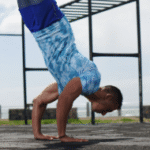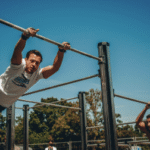Calisthenics for Injury Rehabilitation in Houston, USA
Calisthenics, the art of using your own body weight for strength training, offers a remarkably effective and often superior approach to injury rehabilitation and prevention. In Houston, Texas, where an active lifestyle is common, individuals recovering from injuries or managing chronic pain can significantly benefit from a calisthenics-based rehabilitation program. This methodology, particularly when guided by a knowledgeable coach or physical therapist, allows for controlled, progressive loading that rebuilds strength, improves mobility, and re-establishes functional movement patterns with a focus on body awareness and control.
Why Calisthenics is Ideal for Injury Rehabilitation:
- Controlled & Progressive Loading:
Bodyweight as Resistance: Unlike external weights which can sometimes be too heavy or awkward for an injured joint, bodyweight offers infinitely scalable resistance. Exercises can be regressed (made easier) or progressed (made harder) by simply changing angles, leverage, or support points. For example, a full push-up can be regressed to an incline push-up against a wall, then a knee push-up, allowing for precise loading of healing tissues.
Gradual Adaptation: This precise control means rehabilitation can start very gently and gradually increase in intensity as the tissue heals and strengthens, minimizing the risk of re-injury.
- Functional & Integrated Movements:
Mimicking Daily Life: Calisthenics exercises inherently mimic natural human movements (pushing, pulling, squatting, hinging, carrying, rotating, crawling). This makes the strength gained directly applicable to real-world activities, sports, and occupational demands. For instance, strengthening with squats translates directly to standing up from a chair or lifting objects safely.
Multi-Joint & Multi-Muscle Engagement: Most calisthenics movements are compound, engaging multiple joints and muscle groups simultaneously in a coordinated fashion. This is crucial for rehabilitation as it trains the body as a whole unit, improving synergy and reducing strain on individual muscles or joints.
- Enhanced Body Awareness (Proprioception & Kinesthesia):
Mind-Body Connection: Bodyweight training demands a high level of body awareness. You learn to feel how your body is positioned in space and how different muscles are working. This proprioceptive feedback is vital for re-educating movement patterns post-injury, improving balance, and preventing future mishaps.
Neuromuscular Control: As you gain better control over your body, the communication pathways between your brain and muscles become more efficient, leading to smoother, more controlled, and safer movements.
- Emphasis on Core Stability:
Foundation of Movement: The core muscles are central to almost all human movement and provide essential stability for the spine and pelvis. Almost every calisthenics exercise inherently requires significant core engagement.
Injury Prevention: A strong and stable core is fundamental for protecting the spine, improving posture, and efficiently transferring force throughout the body, thereby preventing injuries, especially in the lower back and extremities.
- Improved Mobility & Flexibility:
Active Range of Motion: Many calisthenics movements require working through a full, controlled range of motion. This active flexibility strengthens muscles at their lengthened positions, improving both strength and joint mobility simultaneously.
Addressing Restrictions: A well-designed calisthenics program can include specific drills to improve restricted mobility, which is often a contributing factor to injuries.
- Low Impact (Generally):
Many calisthenics exercises are low-impact, meaning they place less jarring stress on joints compared to high-impact activities or lifting heavy external weights. This makes them safer for individuals with joint pain or those in early stages of rehabilitation.
How Calisthenics is Applied in Rehabilitation:
- Initial Assessment (Crucial):
A qualified professional (physical therapist or a calisthenics coach with post-rehab expertise) will conduct a thorough assessment, reviewing medical history, injury diagnosis, current pain levels, range of motion, strength, and movement patterns. They may also request reports from your physical therapist or doctor.
- Personalized Program Design:
Based on the assessment, a program is custom-designed, focusing on pain-free movement, correcting imbalances, and gradually strengthening the injured area and surrounding muscles.
Regressions: Exercises will start with the easiest, most stable variations (e.g., wall push-ups, incline rows, assisted squats).
Targeted Activation: Drills will focus on ensuring proper muscle activation around the injured joint, as sometimes muscles “forget” how to fire effectively post-injury.
Progressions: As strength and mobility improve, the exercises will gradually become more challenging, moving towards more advanced bodyweight movements.
- Meticulous Form Correction:
This is paramount. The coach provides real-time, precise feedback on every repetition, ensuring perfect form to prevent re-injury and maximize the therapeutic benefit. Video analysis may be used.
Emphasis on Quality over Quantity: The focus is on executing movements perfectly, even if it means fewer repetitions.
- Integrated Approach:
Calisthenics for rehabilitation often integrates warm-ups, cool-downs, specific mobility drills, stability exercises, and targeted stretches relevant to the injury.
It’s a continuous process that adapts as the individual heals and progresses.
Finding Qualified Professionals for Calisthenics-Based Rehabilitation in Houston:
For residents of Houston, it’s vital to seek out professionals with the right qualifications:
Licensed Physical Therapists (PTs) specializing in Orthopedics/Sports: Many PTs are now incorporating functional bodyweight exercises into their rehabilitation protocols. They can provide a clinical diagnosis and comprehensive rehab plan. Look for clinics in Houston like Sculpt U Physical Therapy, Bulletproof PT, or Houston Methodist Orthopedics & Sports Medicine that emphasize functional strength training.
Certified Personal Trainers with Specialized Credentials: Seek out personal trainers in Houston who hold certifications in:
Corrective Exercise Specialist (e.g., NASM-CES): Focuses on identifying and correcting movement dysfunctions.
Post-Rehabilitation Specialist: Bridging the gap between formal PT and full fitness.
Functional Movement Systems (FMS) Certification: Assess movement patterns to identify limitations.
They should have a strong understanding of anatomy, physiology, and biomechanics, and ideally, experience collaborating with physical therapists.
Important Considerations for Houston Residents:
Medical Clearance: Always obtain medical clearance from your doctor or physical therapist before starting any new exercise program, especially after an injury.
Collaboration: Ideally, your calisthenics coach and physical therapist should communicate to ensure a seamless and safe rehabilitation process.
Patience and Consistency: Rehabilitation is a gradual process. Consistency with your calisthenics exercises and adherence to your personalized program are key to long-term recovery and prevention.
Listen to Your Body: It’s crucial to differentiate between muscle soreness and pain. Never push through pain.
In conclusion, calisthenics offers a powerful, safe, and functional pathway for injury rehabilitation and prevention in Houston. When guided by qualified professionals who understand both the principles of bodyweight training and the nuances of recovery, individuals can effectively rebuild strength, improve movement quality, and regain confidence, leading to a resilient body prepared for an active life in the heart of Texas.
I will now perform searches to verify or add specific information about clinics/coaches in Houston known for calisthenics or functional rehabilitation.
Calisthenics, which uses body weight for strength training, is increasingly recognized in Houston, Texas, as an effective method for injury rehabilitation and prevention. This approach is particularly beneficial for individuals recovering from injuries or managing chronic pain, as it allows for controlled, progressive loading to rebuild strength, improve mobility, and restore functional movement patterns with a strong emphasis on body awareness.
Why Calisthenics is Ideal for Injury Rehabilitation:
- Controlled & Progressive Loading:
Bodyweight as Resistance: Calisthenics offers highly scalable resistance. Exercises can be made easier (regressed) or harder (progressed) by adjusting angles, leverage, or support points. This allows for precise and gradual loading of healing tissues, minimizing the risk of re-injury. For example, a standard push-up can be regressed to an incline push-up against a wall, then a knee push-up, providing a gentle start to strength rebuilding.
Gradual Adaptation: This precise control means that rehabilitation can begin with very light stress on the injured area and gradually increase as tissues heal and strengthen.
- Functional & Integrated Movements:
Mimicking Daily Activities: Calisthenics exercises closely mirror natural human movements like pushing, pulling, squatting, hinging, and rotating. This makes the strength gained directly applicable to everyday tasks, sports, and occupational demands. For instance, mastering a bodyweight squat improves your ability to stand up from a chair or lift objects from the floor safely.
Multi-Joint & Multi-Muscle Engagement: Most calisthenics movements are compound exercises, engaging multiple joints and muscle groups simultaneously. This integrated training is crucial for rehabilitation because it strengthens the body as a whole unit, improving coordination and reducing strain on individual muscles or joints.
- Enhanced Body Awareness (Proprioception & Kinesthesia):
Mind-Body Connection: Bodyweight training inherently demands high levels of body awareness. You learn to feel your body’s position in space and how different muscles are working. This proprioceptive feedback is vital for re-educating movement patterns after an injury, improving balance, and preventing future injuries.
Neuromuscular Control: As you gain better control over your body, the communication pathways between your brain and muscles become more efficient, leading to smoother, more controlled, and safer movements.
- Emphasis on Core Stability:
Foundation of Movement: Core muscles are central to almost all human movement, providing essential stability for the spine and pelvis. Nearly every calisthenics exercise requires significant core engagement, from planks to pull-ups.
Injury Prevention: A strong and stable core protects the spine, improves posture, and efficiently transfers force throughout the body, thereby preventing injuries, especially in the lower back and extremities.
- Improved Mobility & Flexibility:
Active Range of Motion: Many calisthenics movements require working through a full, controlled range of motion. This active flexibility strengthens muscles at their lengthened positions, improving both strength and joint mobility simultaneously.
Addressing Restrictions: A well-designed calisthenics program can include specific drills to improve restricted mobility, which often contributes to injuries.
- Low Impact (Generally):
Many calisthenics exercises are low-impact, placing less stress on joints compared to high-impact activities or lifting heavy external weights. This makes them a safer option for individuals with joint pain or those in the early stages of rehabilitation.
How Calisthenics is Applied in Rehabilitation:
- Initial Assessment (Crucial):
A qualified professional (physical therapist or a calisthenics coach with post-rehab expertise) will conduct a thorough assessment. This includes reviewing your medical history, injury diagnosis, current pain levels, range of motion, strength, and movement patterns. They may also request reports from your physical therapist or doctor to ensure a safe transition.
- Personalized Program Design:
Based on the assessment, a program is custom-designed. It focuses on pain-free movement, correcting imbalances, and gradually strengthening the injured area and surrounding muscles.
Regressions: Exercises will start with the easiest, most stable variations (e.g., wall push-ups, incline rows, assisted squats).
Targeted Activation: Drills focus on ensuring proper muscle activation around the injured joint, as muscles can sometimes “forget” how to fire effectively after an injury.
Progressions: As strength and mobility improve, exercises gradually become more challenging, moving towards more advanced bodyweight movements.
- Meticulous Form Correction:
This is paramount. The coach provides real-time, precise feedback on every repetition, ensuring perfect form to prevent re-injury and maximize therapeutic benefit. Video analysis may be used for detailed review.
Emphasis on Quality over Quantity: The focus is on executing movements perfectly, even if it means fewer repetitions.
- Integrated Approach:
Calisthenics for rehabilitation often integrates warm-ups, cool-downs, specific mobility drills, stability exercises, and targeted stretches relevant to the injury.
It’s a continuous process that adapts as the individual heals and progresses.
Finding Qualified Professionals for Calisthenics-Based Rehabilitation in Houston:
For residents of Houston, it’s vital to seek out professionals with the right qualifications:
Licensed Physical Therapists (PTs) specializing in Orthopedics/Sports: Many PTs are now incorporating functional bodyweight exercises into their rehabilitation protocols. They can provide a clinical diagnosis and comprehensive rehab plan. Look for clinics in Houston like Sculpt U Physical Therapy, Bulletproof PT, or Houston Methodist Orthopedics & Sports Medicine that emphasize functional strength training.
Certified Personal Trainers with Specialized Credentials: Seek out personal trainers in Houston who hold certifications in:
Corrective Exercise Specialist (e.g., NASM-CES): Focuses on identifying and correcting movement dysfunctions.
Post-Rehabilitation Specialist: Bridges the gap between formal PT and full fitness.
Functional Movement Systems (FMS) Certification: Assesses movement patterns to identify limitations.
These trainers should have a strong understanding of anatomy, physiology, and biomechanics, and ideally, experience collaborating with physical therapists. The Body Master Fitness Studio mentions Post Rehabilitation Training with a certified rehabilitation exercise specialist (RES). Mekanix Gym also highlights their coaches’ ability to tailor exercises for injury prevention and provide recovery options like contrast therapy.
Important Considerations for Houston Residents:
Medical Clearance: Always obtain medical clearance from your doctor or physical therapist before starting any new exercise program, especially after an injury.
Collaboration: Ideally, your calisthenics coach and physical therapist should communicate to ensure a seamless and safe rehabilitation process.
Patience and Consistency: Rehabilitation is a gradual process. Consistency with your calisthenics exercises and adherence to your personalized program are key to long-term recovery and prevention.
Listen to Your Body: It’s crucial to differentiate between muscle soreness and pain. Never push through pain.
In conclusion, calisthenics offers a powerful, safe, and functional pathway for injury rehabilitation and prevention in Houston. When guided by qualified professionals who understand both the principles of bodyweight training and the nuances of recovery, individuals can effectively rebuild strength, improve movement quality, and regain confidence, leading to a resilient body prepared for an active life in the heart of Texas.

Calisthenics for Injury Rehabilitation in Houston, USA
Route
Calisthenics Gym Houston Functional Bodyweight Training
Secondary phone: (346) 483-3195
Email: info@calisthenicsclubhouston.com
URL: https://calisthenicsclubhouston.com/
Monday 6:00 AM - 7:00 PM Tuesday 6:00 AM - 7:00 PM Wednesday 6:00 AM - 7:00 PM Thursday 6:00 AM - 7:00 PM Friday 12:00 PM - 6:30 PM Saturday 9:45 AM - 12:00 PM Sunday 3:00 PM - 5:00 PM







